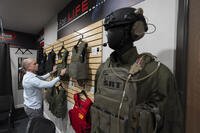SALON DU BOURGET, France -- As the deadline nears for the Air Force to select a new trainer to replace its T-38 Talon, manufacturer Leonardo is bullish that its offering will prove a safe choice with the best value for the service.
Here at the Paris Air Show, Leonardo displayed a full-size mock-up of the T-100, its submission for the T-X trainer competition, in the shadow of the M-346 Master, the veteran trainer it's closely based on.
While the company had a T-100 display last year at the Farnborough International Airshow in England, it appeared for a while that the program would be dead well ahead of Paris.
Its bid appeared to have hit an insurmountable obstacle in January when partner company Raytheon pulled out of the competition. But in February, Leonardo announced it was back in the running, led by U.S.-based arm DRS.
Leonardo faces steep competition from companies including Boeing, which is offering a clean-sheet design, and a Lockheed Martin-Korea Aerospace Industries team, with the supersonic T-50 Golden Eagle, which has been training South Korean pilots since the mid-2000s.
Rico Vaca, a T-100 subject matter expert for Leonardo DRS, told Military.com he believes the reliability of the design and its competitive price point will win the day for the company. The M-346, which is in most ways identical to the proposed T-100, is currently training pilots in Israel, Italy, Poland and Singapore to fly the F-35 Joint Strike Fighter. And, he said, more countries are in talks to acquire the aircraft.
"The fact that we're in production -- you talk about low cost, min risk, if that's really what you're looking for -- there's no less risk than an airplane that's in production that's been being built for seven or eight years," he said.
While the M-346 reportedly costs about $37 million per plane, Vaca said he expects the unit cost of the T-100 to come well under that figure. The company achieved some savings by removing hardware that the Air Force didn't call for, such as a refueling probe. The loss of the Raytheon partnership may ultimately spell savings too.
"Not having a partner with Raytheon, is that good or bad? It turns out that it's actually pretty good," Vaca said. "So now we're one manufacturer building the airplane. So a lot of the fees, a lot of the issues that went along with partnering, we can take out of the system so it allows us to get to a lower price."
There may be other savings outside the cost of the aircraft too, he said. Israeli pilot trainees used to train on the T-346 and then spend time on an F-16 Fighting Falcon before transitioning to the F-35, he said, but ultimately decided the trainer was effective enough that they didn't need the middle step.
"There's a lot of value and cost savings that you're not going to take into account in the [request for proposals], but if you can shorten the syllabus because the airplane will be airborne longer and you can get rid of a part of training, there's long-term savings there as well," he said.
For now, the T-X competition is largely a waiting game. Companies in the running are supposed to submit flight data to the Air Force by the end of this month, and the service is expected to pick a winner by the end of the year. The service is expected to purchase 350 of the trainers.









